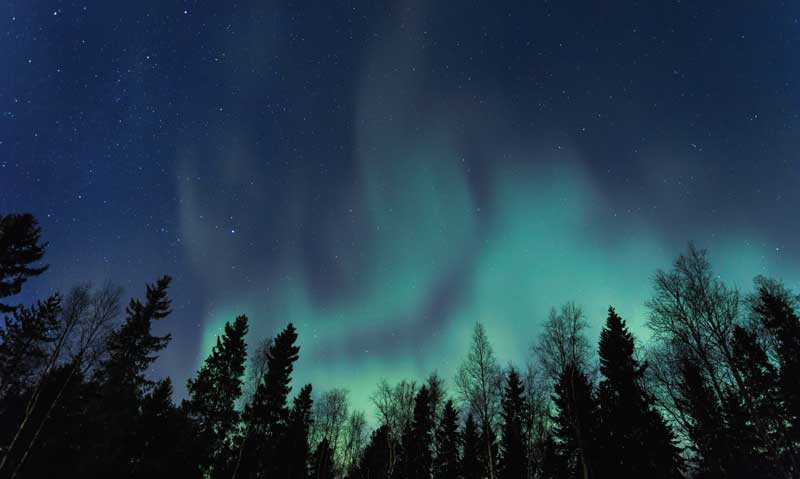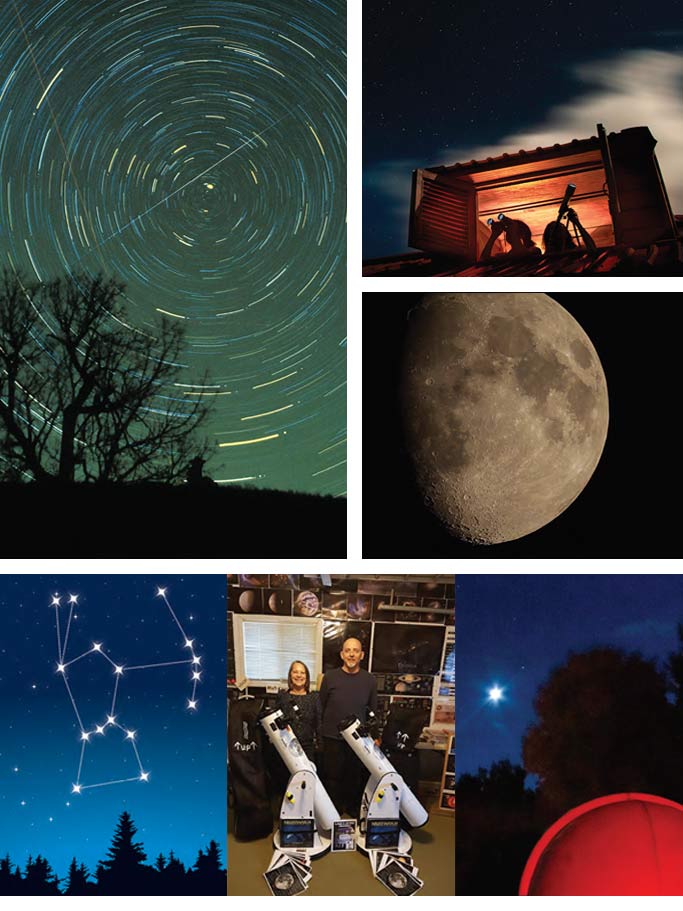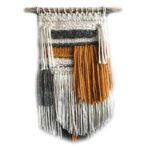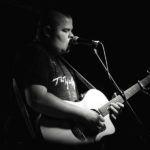

clockwise from top left: Meteor shower in Geminid courtesy NASA; A Magical Night photo by Zach Silverstein; full moon courtesy Dortwood Observatory; Red Observatory photo by Angus Deschamps Sr.; David Doherty & Carolyn Wood, photo courtesy Dortwood Observatory; Constellation Orion
Bundle up and head outside this winter to see the greatest show in the universe!
The most “binge-worthy” show this winter will be happening right above your own backyard. Astronomers are urging people to venture outside and look up into the night sky for what promises to be an eventful winter
The best time of month is when there’s a new moon, says David Doherty, co-owner (along with his wife Carolyn Wood) of the Dortwood Observatory, a privately owned, not-for-profit observatory located just south of Camborne.
“To astronomers, this is like when the theatre lights dim and the show starts,” he explains. “The darker sky means we can see fainter and more distant objects. So we’ll be able to see constellations in Orion with the naked eye, and also the spectacular Geminids meteor shower!”
The Geminids shower (caused by Earth passing through a stream of dust left by an asteroid called 3200 Phaethon) will peak this year between December 13 and 14. It promises almost 120 shooting stars per hour, it lasts for almost 24 hours, and it’s visible as early as 9:00 p.m. Even the most casual observer should have ample opportunity to spot at least one shooting star without having to stay up until the wee hours. David’s “must see” list this winter also includes a rare conjunction of Jupiter and Saturn (where the two planets appear very close together in the sky) on December 21.
“You still have to be patient, but if you get away from streetlights, and spend at least 30 minutes outside so your eyes can get accustomed to looking at the night sky, it will be an unforgettable sight,” says Carolyn.
Carolyn has seen many unforgettable celestial events herself, but there is one meteor sighting in particular that she will never forget.
“I was camping with a friend in Virginia and I saw this huge, bright meteor streak across the sky. The following week I was back home and met up with some friends at a bar in Cobourg. David overheard me telling them about it and joined our conversation, as he had seen it too. We talked about astronomy for hours and we’ve been talking about the stars ever since,” she jokes.
The couple took their love of stargazing a step further when they decided to build a small observatory in their backyard and started hosting “open house” events for family, friends and neighbours.
“It evolved from giving a few people advice on what telescopes to buy, to having groups of people coming over to view events like lunar eclipses and meteor showers. There were so many interested friends that I decided to convert our garage space into a mini education centre,” laughs David.
David uses Oreo cookies to explain the phases of the moon and demonstrates how to measure distances in space using your hands.
Impressed by the couple’s enthusiasm and ability to simplify complicated astronomical concepts (David uses Oreo cookies to explain the phases of the moon and demonstrates how to measure distances in space using your hands), teachers started requesting David to speak at their local schools.
“My first presentation was about the sun, because it’s visible during the day,” says David. “I brought solar glasses (the ones you use during a solar eclipse) for the kids so they could safely view the sun’s outer rim and maybe even a solar flare. The kids were excited about that, but I also wanted them to experience planets in the night sky.”
David and Carolyn decided to donate some high quality, but “kid-friendly” telescopes to local libraries. The Loan-A-Scope program allows for overnight borrowing of a telescope and includes a pamphlet illustrating basic telescope viewing techniques. It was so successful that the telescopes were booked a month in advance.
Carolyn points out that you don’t need a telescope to see the majority of constellations and things in the night sky.
“For the aurora borealis – or northern lights – it’s actually more impressive to watch without a telescope,” she says.
Auroras occur when the sun emits charged particles. These particles get trapped by the Earth’s magnetic field and are drawn to the north and south poles. When the particles collide with nitrogen and oxygen in the atmosphere, they produce the dancing waves of green, blue and red light we call aurora borealis (in the northern hemisphere) and the aurora australis (in the southern hemisphere).
Carolyn explains that because this year the sun is just starting another activity cycle, the aurora might not be vivid green, but rather will light up the sky in an incredible luminous glow.
“Really the most important thing we need for viewing these events in the night sky is darkness. It sounds simple, but with all the light pollution and interference from satellites, it’s becoming harder for us to see the stars!” she adds.
With this in mind, the couple joined “Globe at Night” (globeatnight.org), an organization that monitors the effects of global light pollution. The campaign began 14 years ago and uses video, photographs and recorded observations submitted from citizen scientists around the world. The early findings have helped scientists to find links between artificial light pollution and certain ecosystem disruptions or even adverse health effects on humans.
The campaign even prompted SpaceX to coat their Starlink internet satellites in a non-reflective material, which makes them less bright and not as likely to interfere with astronomical research.
David and Carolyn are also participating in another global project, initiated and funded in part by Wayne Parker, bass player for the Canadian music group Glass Tiger.
“Wayne started the Starships Project, which is basically building observatories all over the world that will be run by people like us to provide hands-on astronomy education. Eventually they will all be connected via the internet, sharing information and broadcasting live on the Starships video network,” says David.
He has been in talks with both the Starships Project organizers and the Township of Cramahe to build an observatory on donated farmland in Morganston, south of Warkworth.
“Progress has slowed down because of COVID, but we hope to be welcoming people to the observatory in the next year or two,” David says.
In the meantime, David and Carolyn are encouraging people to bundle up, go outside and use free smartphone apps like Sky Map or NASA’s own app to help locate constellations, planets and satellites in the night sky.
“Those apps are great because you just point your phone up to the sky and it will tell you exactly what you are looking at,” he says.
The apps will even tell you how and when to spot an object that’s a bit nearer to home.
“It’s always thrilling to see the International Space Station zooming by,” David smiles.
Close to Earth or far away in the cosmos, there’s lots to see this winter if you simply look up.
During COVID-19, Dortwood Observatory has started live streaming on facebook.com/DortwoodObservatory
Story by:
Micol Marotti




